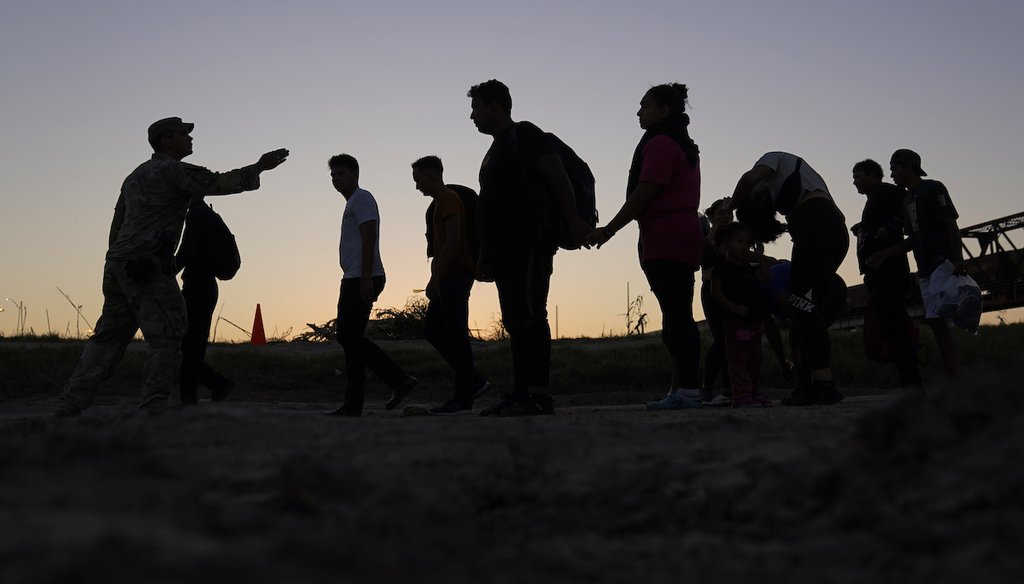Get PolitiFact in your inbox.

Migrants who crossed the Rio Grande and entered the U.S. from Mexico are lined up for processing by U.S. Customs and Border Protection, Sept. 23, 2023, in Eagle Pass, Texas. (AP)
If Your Time is short
-
Each branch of government has a role in immigration policy and the actions and inactions of each affect the other.
-
Congress passes immigration laws, but hasn’t passed anything new in decades. The president can enact executive orders, but these can be changed during each administration. And the courts can stop or restart policies, but that can cause confusion or instability.
-
Our mission: Help you be an informed participant in democracy. Learn more.
Images of thousands of people crowded at the southern U.S. border have permeated President Joe Biden’s time in office. Republicans in Congress blame Biden for the high number of illegal crossings. The White House says it’s Congress’ responsibility to update immigration laws.
As members from separate branches of government point fingers at one another, the persistent situation at the border leaves voters with plenty of questions.
"What branch of government is ‘really’ responsible for the crisis at the border?" a reader asked PolitiFact in an email. Is it the president or Congress? "I realize it’s very complicated," the email-writer acknowledged.
Our reader is right that unpacking who is to blame for the high numbers of immigrants at the border is complicated, but we spoke with four immigration experts to get their insight. Each expert gave us a different perspective. Here’s what they said.
Immigration is the responsibility of the federal government, and the U.S. political system is set up so that each branch checks and balances the other. This makes it difficult to blame only one branch.
"Each of the three branches of government has a role to play in immigration law and policy, and each has failed," said Cornell University immigration law professor, Stephen Yale-Loehr. "The result: a quagmire, where nothing gets resolved and matters get worse every day. Every branch of government is to blame."
Rick Su, an immigration law professor at the University of North Carolina, Chapel Hill said, in his opinion, no branch of government is "‘responsible’ for the crisis at the border." Chaos and instability in Latin American countries are the underlying cause, he said.
"I think there are more push factors driving people to leave (their home countries) than there are pull factors luring them in (to the U.S.)," Su said.
But the president is "responsible for dealing with it," Su said. However, he added that "the executive can only operate within the laws and funding from the legislature, and it is also subject to the review and orders of the court."
Large numbers of immigrants are reaching the border because of a lack of legal avenues to otherwise enter the country, said Elizabeth Aranda, director of the University of South Florida’s Immigrant Well-Being Research Center.
"For this reason, if I had to name one branch most responsible, it would be Congress given that they have not updated immigration laws since the 1990s," Aranda said.
Guadalupe Correa-Cabrera, a George Mason University immigration expert, echoed Aranda’s sentiment saying the broken immigration system is to blame for a crisis that goes beyond the border.
The legislative branch is in charge of passing and changing immigration laws. This means it’s up to the House of Representatives and the Senate to decide how people come to the U.S., and what penalties people face if they enter the country illegally. Congress also has a final say on how much funding is appropriated to the agencies that implement those immigration laws.
For example, Congress passed the laws that created the definition for asylum, and the process people undergo to get it. Under the law, people must be on U.S. soil to seek asylum. If they entered the country illegally, people seek asylum via the immigration court system as a defense against deportation. Under the law, people must be detained throughout this process.
However, Congress hasn’t provided enough funding to quickly adjudicate asylum cases, leading to a backlog of millions of cases, or to detain every person who seeks asylum.
"The laws and funding should also be revised to accommodate changing circumstances," Su said.
But Congress hasn’t passed an immigration bill in more than 30 years, despite multiple attempts at reaching a compromise.
Although Congress is charged with creating immigration laws, it’s up to the executive branch to implement those laws. This includes the president and various departments and agencies such as the Department of Homeland Security, the State Department and the Department of Justice.
The lack of congressional action has left the president with the responsibility of handling an evolving immigration environment amid stagnant laws.
"Despite the fact that all three branches have responsibilities," Su said, "the executive is the most visible. As a result, the executive branch tends to get all the attention, and both the credit and the blame."
For example, former President Donald Trump created the Migrant Protection Protocols or "Remain in Mexico" program, requiring certain immigrants to remain in Mexico while awaiting a decision on their U.S. asylum cases. Biden has used his authority to grant humanitarian parole to allow certain people to legally work and stay in the U.S. for two-year periods.
Although presidents can create immigration policies and programs, these are often temporary, Correa-Cabrera said. This ties the executive branch’s hands when it comes to immigration, she said.
The courts are responsible for ensuring that laws are constitutional, and that the policies presidents make are in line with the laws Congress passed. As presidents increasingly rely on executive actions because of Congress’ inaction, the courts have become more active in ruling on immigration policies.
Court cases take a long time to be resolved, so immigration programs are often restarted or paused in the meantime. This leads to uncertainty and confusion as immigration policies are in flux.
For example, Trump enacted the "Remain in Mexico" program, and Biden rescinded it when he entered office. A group of Republican-led states sued the Biden administration for ending the program, leading a federal judge to order its revival. Eventually, the Supreme Court ruled that the program could be ended.
The courts have both ruled with and against the executive branch under both Republican and Democratic administrations, Yale-Loehr said.
"Thus, people don’t know how courts will rule, which reduces predictability," he said. "Moreover, litigation takes time, and is not a good way to manage immigration law and policy."
RELATED: Republicans and Democrats claim to support Dreamers. So why can’t they pass a law?
RELATED: All our fact-checks about immigration and border security
Our Sources
Brookings Institute, Can immigration reform happen? A look back, Feb. 11, 2019
U.S. Department of Homeland Security, Migrant Protection Protocols, Jan. 24, 2019
American Immigration Council, The Biden Administration’s Humanitarian Parole Program for Cubans, Haitians, Nicaraguans, and Venezuelans: An Overview, Oct. 31, 2023
The Texas Tribune, Texas sues Biden administration in effort to reinstate Trump-era "remain in Mexico" immigration policy, April 13, 2021
CNN, Federal judge orders Biden administration to revive Trump-era border policy, Aug. 14, 2021
PolitiFact, Explaining the Supreme Court immigration ruling on ‘Remain in Mexico’, July 7, 2022
Phone interview, Guadalupe Correa-Cabrera, professor at the Schar School of Policy and Government, George Mason University, Jan. 16, 2024
Email exchange, Stephen Yale-Loehr, professor of immigration law practice at Cornell University, Jan. 16, 2024
Email exchange, Rick Su, professor of law at University of North Carolina Chapel Hill, Jan. 16, 2024
Email exchange, Elizabeth Aranda, professor of sociology and director of the Immigrant Well-Being Research Center at the University of South Florida, Jan. 17, 2024




































